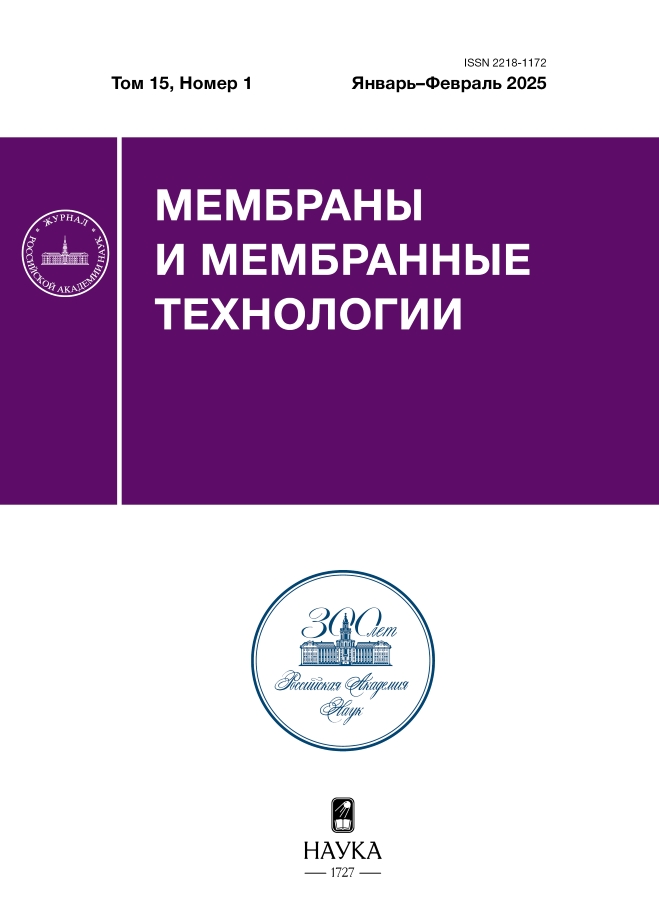Distillation of Nonelectrolyte Solutions Using Reverse Osmosys Hydrophilic Membranes
- Autores: Filippov A.N.1
-
Afiliações:
- Gubkin University
- Edição: Volume 15, Nº 1 (2025)
- Páginas: 33-43
- Seção: Articles
- URL: https://ruspoj.com/2218-1172/article/view/685291
- DOI: https://doi.org/10.31857/S2218117225010039
- EDN: https://elibrary.ru/LBAEGI
- ID: 685291
Citar
Texto integral
Resumo
A mathematical model of membrane distillation of aqueous solutions of organic substances (alcohols) using hydrophilic membranes has been developed. The membrane is modeled as a capillary-porous body all the pores of which are rectilinear capillaries of the same length and radius. The study was carried out for moderately intense processes, when the radius of curvature of the meniscus of a cylindrical pore exceeds the radius of the capillary, that is, there is no deepening of the evaporation front. An analytical formula was obtained, its parametric study was carried out and the extreme behavior of the separation coefficient of the most membrane-trapped component of the mixture was revealed depending on the concentration of solvent vapor in the blowing gas stream, which qualitatively corresponds to the behavior of this coefficient during the pervaporation of aqueous ethanol solutions using crosslinked hydrophilic pullulane membranes and hydrophilic chitosan membranes, as well as chitosan membranes crosslinked with glutaraldehyde.
Texto integral
Sobre autores
A. Filippov
Gubkin University
Autor responsável pela correspondência
Email: filippov.a@gubkin.ru
ORCID ID: 0000-0001-9903-2405
Código SPIN: 7388-6159
Scopus Author ID: 35613864900
Researcher ID: C-5326-2014
Higher Mathematics Department, “Physicochemical hydrodynamics of two-phase flows in porous media” Laboratory
Rússia, 65 Leninsky Prospect, building 1, Moscow, 119991Bibliografia
- Брык М.Т., Нигматуллин Р.Р. Мембранная дистилляция // Успехи химии. 1995. Т. 63 (12). С. 1114–1129.
- Uragami T., Saito M., Takigawa K. Comparison of permeation and separation characteristics for aqueous alcoholic solutions by pervaporation and new evapomeation methods through chitosan membranes // Macromol. Chem., Rapid Commun. 1988. V. 9. P. 361–365.
- Okuno H., Ikeda N., Nishimoto H., Matsumoto A., Uragami T. Preparation of Copolymer Membranes from Hydrophilic and Hydrophobic Monomers and Permselectivities of Their Membranes for Aqueous Ethanol Solutions by Pervaporation and Evapomeation // SEN-I GAKKAISHI Transaction. 1991. V. 47 (12). P. 650–656.
- Uragami T., Matsuda T., Okuno H., Miyata T. Structure of chemically modified chitosan membranes and their characteristics of permeation and separation of aqueous ethanol solutions // J. Membr. Sci. 1994. V. 88. P. 243–251.
- Виноградов И.И., Дрожжин Н.А., Кравец Л.И., Россоу А., Вершинина Т.Н., Нечаев А.Н. Формирование гибридных мембран для обессоливания водных растворов методом мембранной дистилляции // Коллоидн. журн. 2024. Т. 86 (5). С. 533–548.
- Kujawska A., Kujawski J.K., Bryjak M., Cichosz M., Kujawski W. Removal of volatile organic compounds from aqueous solutions applying thermally driven membrane processes. 2. Air gap membrane distillation // J. Membr. Sci. 2016. V. 499. P. 245–256.
- Lee C.H., Hong W.H. Effect of operating variables on the flux and selectivity in sweep gas membrane distillation for dilute aqueous isopropanol // J. Membr. Sci. 2001. V. 188. P. 79–86.
- Troshkin A.R., Khanukaeva D.Yu., Aleksandrov P.A., Filippov A.N. Mathematical modeling of stationary thermopervaporation through hydrophobic membrane // J. Mol. Liq. 2025. V. 417. Article 126585.
- Derjaguin B.V., Churaev N.V., Martynov G.A. The theory of the reverse osmosis separation of solutions using fine-porous membranes // J. Colloid & Interface Sci. 1980. V. 75 (2). P. 419–434.
- Мелвин-Хьюз Э.А. Физическая химия. Т. 2. М.: Изд-во иностр. лит., 1962.
- Uragami T., Takigawa K. Permeation and separation characteristics of ethanol-water mixtures through chitosan derivative membranes by pervaporation and evapomeation // Polymer. 1990. V. 31 (4). P. 668–672.
- Uragami T., Matsuda T., Okuno H., Miyata T. Structure of chemically modified chitosan membranes and their characteristics of permeation and separation of aqueous ethanol solutions // J. Membr. Sci. 1994. V. 88. P. 243–251.
- Okuno H., Uragami T. Characteristics of permeation and separation of aqueous alcohol solutions through crosslinked pullulan membranes // Polymer. 1992. V. 33 (7). P. 1459–1463.
- Uragami T. Pervaporation and Evapomeation with Si-Containing Polymers // Membrane Materials for Gas and Vapor Separation: Synthesis and Application of Silicon-Containing Polymers. 1st ed. Ed. by Yu. Yampolskii and Eu. Finkelshtein. John Wiley & Sons Ltd., 2017. P. 335–372.
- Nawawi M.G.M., Hassan H. Pervaporation separation of isopropanol-water mixtures using crosslinked chitosan membranes // Jurnal Teknologi. 2003. Keluaran Khas. Dis. 39 (A). P. 55–64.
Arquivos suplementares















